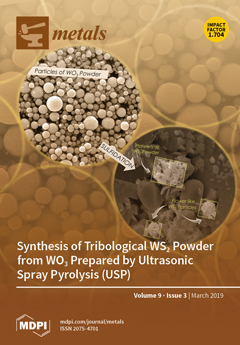In this study, the soft magnetic properties of Fe
78Si
9B
13 amorphous magnetic powder cores (AMPCs) were enhanced by coordinately adjusting the technological parameters, including the particle size distribution, molding pressure, and coating agent content, in the industrial condition. The
[...] Read more.
In this study, the soft magnetic properties of Fe
78Si
9B
13 amorphous magnetic powder cores (AMPCs) were enhanced by coordinately adjusting the technological parameters, including the particle size distribution, molding pressure, and coating agent content, in the industrial condition. The results show that the optimized comprehensive soft magnetic properties of the Fe
78Si
9B
13 AMPCs could be obtained under the following process conditions: (1) the distribution of particle size is 20 wt.% for 140–170 mesh, 70 wt.% for 170–270 mesh, and 10 wt.% for 270–400 mesh; (2) the molding pressure is in the range of 2.35–2.45 GPa; and (3) the additive amount of sodium silicate is 1.5 wt.%. After the collaborative optimization, the AMPCs’ compact density,
ρ, the effective permeability,
μe, and the residual effective permeability at the applied magnetizing field of 7.96 kA/m,
μe@7.96 kA/m, increased from 5.61 g/cm
3 to 5.86 g/cm
3, from 58.13 to 77.01, and from 40.36 to 49.57, respectively. The attenuation ratio of the effective permeability, when in the frequency band of 20–100 kHz, was less than 0.85%. The core loss at the 50 kHz for the maximum magnetic flux density of 0.1 T reduced from 380.85 mW/cm
3 to 335.23 mW/cm
3. This work will encourage the further application of Fe-based AMPCs in the fields of electronics and telecommunication.
Full article





